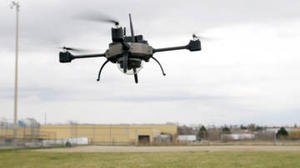Law enforcement technologyQuadrotor micro UAVs go mainstream
A Canadian company develops small quadrotor micro UAVs for use by law enforcement, first responders, and the military; the company’s Scout has a range of three kilometers and maximum speed of 50 kilometers per hour; it can fly through wind gusts of up to 80 km/h, and can cope with harsh weather conditions; the Scout is light — it weighs about one kilogram — and can be carried disassembled in a case and be assembled quickly by snapping its rotors into the main body

Aeryon's quadrotor micro UAC during testing // Source: aeryon.com
Waterloo, Ontario, Canada-based Aeryon Labs develops and builds quadrotors — vertical take-off and landing (VTOL) micro unmanned aerial vehicles which are used for tactical, over-the-hill aerial intelligence.
The company touts its Scout quadrotor micro UAV as an ideal surveillance toll for law enforcement, first responders, and the military. The Scout has a range of three kilometers and maximum speed of 50 kilometers per hour. It can fly through wind gusts of up to 80 km/h, and can cope with harsh weather conditions. The Scout is light – it weighs about one kilogram — and can be carried disassembled in a case and be assembled quickly by snapping its rotors into the main body.
The user can choose between an optical zoom digital camera or a thermal camera for nighttime surveillance. Also, the machine’s camera mount is gyro-stabilized, so even if the UAV is moving, it can keep the cameras locked on a target.
The IEEE Spectrum reports that the Aeryon Labs emphasizes the UAV’s usability. The Scout uses a touchscreen-based control interface, which the company says is much easier to master than traditional controllers. The Scout carries an onboard computer, GPS, gyros, and other sensors that keep the UAV stable and in position.
The ground-based pilot uses a tablet PC to direct the machine in a Google Maps-style view and monitor live video streamed from the UAV.
Aeryon Labs says that one police force, the Halton Regional Police in Ontario, Canada, is using the Scout, and others are testing it. A company called Geo-Rhea is flying it to collect environmental data, including, for example, the size of coal piles. BP used several Scouts to monitor the oil spill during its clean-up efforts in the Gulf.
